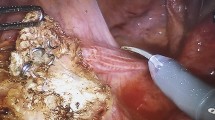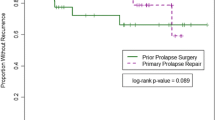Abstract
Background
Robotic ventral mesh rectopexy (RVMR) is an appealing approach for the treatment of rectal prolapse and other conditions. The aim of this study was to evaluate the outcomes of RVMR for rectal prolapse.
Methods
We performed a retrospective chart review for patients who underwent RVMR for rectal prolapse at our institution between July 2012 and May 2016. Any patient who underwent RVMR during this time frame was included in our analysis. Any cases involving colorectal resection or other rectopexy techniques were excluded.
Results
Of the 24 patients who underwent RVMR, 95.8% of patients were female. Median age was 67.5 years old (IQR 51.5–73.3), and 79.2% of patients were American Society of Anesthesiologists class III or IV. Median operative time was 191 min (IQR 164.3–242.5), and median length of stay was 3 days (IQR 2–3). There were no conversions, RVMR-related complications or mortality. Patients were followed for a median of 3.8 (IQR 1.2–15.9) months. Full-thickness recurrence occurred in 3 (12.4%) patients. Rates of fecal incontinence improved after surgery (62.5 vs. 41.5%, respectively) as did constipation (45.8 vs. 33.3%, respectively). No patients reported worsening symptoms postoperatively. Only one (4.2%) patient reported de novo constipation postoperatively.
Conclusions
RVMR is a feasible, safe and effective option for the treatment of rectal prolapse, with low short-term morbidity and mortality. Multicenter and long-term studies are needed to better assess the benefits of this procedure.


Similar content being viewed by others
References
Hrabe J, Gurland B (2016) Optimizing treatment for rectal prolapse. Clin Colon Rectal Surg 29(3):271–276. doi:10.1055/s-0036-1584505
Tou S, Brown SR, Nelson RL (2015) Surgery for complete (full-thickness) rectal prolapse in adults. Cochrane Database Syst Rev 11:Cd001758. doi:10.1002/14651858.CD001758.pub3
Van Iersel JJ, Paulides TJ, Verheijen PM, Lumley JW, Broeders IA, Consten EC (2016) Current status of laparoscopic and robotic ventral mesh rectopexy for external and internal rectal prolapse. World J Gastroenterol 22(21):4977–4987. doi:10.3748/wjg.v22.i21.4977
De Hoog DE, Heemskerk J, Nieman FH, Van Gemert WG, Baeten CG, Bouvy ND (2009) Recurrence and functional results after open versus conventional laparoscopic versus robot-assisted laparoscopic rectopexy for rectal prolapse: a case–control study. Int J Colorectal Dis 24(10):1201–1206. doi:10.1007/s00384-009-0766-3
Heemskerk J, DE De Hoog, Van Gemert WG, Baeten CG, Greve JW, Bouvy ND (2007) Robot-assisted vs. conventional laparoscopic rectopexy for rectal prolapse: a comparative study on costs and time. Dis Colon Rectum 50(11):1825–1830. doi:10.1007/s10350-007-9017-2
Makela-Kaikkonen J, Rautio T, Klintrup K et al (2014) Robotic-assisted and laparoscopic ventral rectopexy in the treatment of rectal prolapse: a matched-pairs study of operative details and complications. Tech Coloproctol 18(2):151–155. doi:10.1007/s10151-013-1042-7
Makela-Kaikkonen J, Rautio T, Paakko E, Biancari F, Ohtonen P, Makela J (2016) Robot-assisted vs laparoscopic ventral rectopexy for external or internal rectal prolapse and enterocele: a randomized controlled trial. Colorectal Dis 18(10):1010–1015. doi:10.1111/codi.13309
Makela-Kaikkonen JK, Rautio TT, Koivurova S et al (2016) Anatomical and functional changes to the pelvic floor after robotic versus laparoscopic ventral rectopexy: a randomised study. Int Urogynecol J 27(12):1837–1845. doi:10.1007/s00192-016-3048-y
Mantoo S, Podevin J, Regenet N, Rigaud J, Lehur PA, Meurette G (2013) Is robotic-assisted ventral mesh rectopexy superior to laparoscopic ventral mesh rectopexy in the management of obstructed defaecation? Colorectal Dis 15(8):e469–e475. doi:10.1111/codi.12251
Perrenot C, Germain A, Scherrer ML, Ayav A, Brunaud L, Bresler L (2013) Long-term outcomes of robot-assisted laparoscopic rectopexy for rectal prolapse. Dis Colon Rectum 56(7):909–914. doi:10.1097/DCR.0b013e318289366e
Germain A, Perrenot C, Scherrer ML et al (2014) Long-term outcome of robotic-assisted laparoscopic rectopexy for full-thickness rectal prolapse in elderly patients. Colorectal Dis 16(3):198–202. doi:10.1111/codi.12513
Mehmood RK, Parker J, Bhuvimanian L et al (2014) Short-term outcome of laparoscopic versus robotic ventral mesh rectopexy for full-thickness rectal prolapse. Is robotic superior? Int J Colorectal Dis 29(9):1113–1118. doi:10.1007/s00384-014-1937-4
Ramage L, Georgiou P, Tekkis P, Tan E (2015) Is robotic ventral mesh rectopexy better than laparoscopy in the treatment of rectal prolapse and obstructed defecation? A meta-analysis. Tech Coloproctol 19(7):381–389. doi:10.1007/s10151-015-1320-7
Rondelli F, Bugiantella W, Villa F et al (2014) Robot-assisted or conventional laparoscopic rectopexy for rectal prolapse? Systematic review and meta-analysis. Int J Surg 12(Suppl 2):S153–S159. doi:10.1016/j.ijsu.2014.08.359
Wong MT, Meurette G, Rigaud J, Regenet N, Lehur PA (2011) Robotic versus laparoscopic rectopexy for complex rectocele: a prospective comparison of short-term outcomes. Dis Colon Rectum 54(3):342–346. doi:10.1007/DCR.0b013e3181f4737e
Faucheron J-L, Trilling B, Barbois S, Sage P-Y, Waroquet PA, Reche F (2016) Day case robotic ventral rectopexy compared with day case laparoscopic ventral rectopexy: a prospective study. Tech Coloproctol 20:695–700. doi:10.1007/s10151-016-1518-3
Ayav A, Bresler L, Hubert J, Brunaud L, Boissel P (2005) Robotic-assisted pelvic organ prolapse surgery. Surg Endosc 19(9):1200–1203. doi:10.1007/s00464-004-2257-5
Heemskerk J, Zandbergen R, Maessen JG, Greve JW, Bouvy ND (2006) Advantages of advanced laparoscopic systems. Surg Endosc 20(5):730–733. doi:10.1007/s00464-005-0456-3
Zihni AM, Ohu I, Cavallo JA, Cho S, Awad MM (2014) Ergonomic analysis of robot-assisted and traditional laparoscopic procedures. Surg Endosc 28(12):3379–3384. doi:10.1007/s00464-014-3604-9
Lawson EH, Curet MJ, Sanchez BR, Schuster R, Berguer R (2007) Postural ergonomics during robotic and laparoscopic gastric bypass surgery: a pilot project. J Robot Surg 1(1):61–67. doi:10.1007/s11701-007-0016-z
Consten EC, Van Iersel JJ, Verheijen PM, Broeders IA, Wolthuis AM, D’hoore A (2015) Long-term outcome after laparoscopic ventral mesh rectopexy: an observational study of 919 consecutive patients. Ann Surg 262(5):742–747. doi:10.1097/sla.0000000000001401 (discussion 747–748)
Senapati A, Gray RG, Middleton LJ et al (2013) PROSPER: a randomised comparison of surgical treatments for rectal prolapse. Colorectal Dis 15(7):858–868. doi:10.1111/codi.12177
Mantoo S, Rigaud J, Naulet S, Lehur PA, Meurette G (2014) Standardized surgical technique and dedicated operating room environment can reduce the operative time during robotic-assisted surgery for pelvic floor disorders. J Robot Surg 8(1):7–12. doi:10.1007/s11701-013-0411-6
Author information
Authors and Affiliations
Corresponding author
Ethics declarations
Conflict of interest
JCC and AP are MedRobotics consultants. AP is an Intuitive consultant and was provided institutional support to host educational conferences. MDJ, SDM, JCC, MJS and AP were provided Ethicon institutional support to host educational conferences. MJS is an Ethicon consultant and lecturer, and received a grant.
Ethical approval
This study was approved by the Institutional Review Board at the University of California, Irvine. All procedures performed were in accordance with the ethical standards of the Institutional Review Board and with the 1964 Helsinki declaration and its later amendments or comparable ethical standards.
Informed consent
This study did not require formal consent, as determined by our Institutional Review Board.
Rights and permissions
About this article
Cite this article
Inaba, C.S., Sujatha-Bhaskar, S., Koh, C.Y. et al. Robotic ventral mesh rectopexy for rectal prolapse: a single-institution experience. Tech Coloproctol 21, 667–671 (2017). https://doi.org/10.1007/s10151-017-1675-z
Received:
Accepted:
Published:
Issue Date:
DOI: https://doi.org/10.1007/s10151-017-1675-z




